Mary Ann Lynch
Happy Valentine’s Day! What better way to celebrate this day devoted to LOVE than to explore the international and enduring Valentine, Marilyn Monroe…
The name Mary Ann Lynch probably sounds familiar. She might have been a juror for a show you submitted to, or perhaps you’ve visited her Not for Profit Photography Network. Maybe you have read her articles in Color and B&W magazines, featuring photographers such as Dave Anderson and Roger Ballen, read one of her essays or books, or been one of her students. You might have seen her work in exhibitions around the world. Needless to say, her name is a significant one in the fine art photography community.
But what you may not know about Mary Ann, is that she has been photographing images of Marilyn Monroe for the past 20 years and has created the project, FOREVER MARILYN, The Enduring Legacy of Marilyn Monroe .
Mary Ann writes: Marilyn Monroe once wrote, “Hold a good thought for me.” That we do, and more, for we have kept her among us for decades, since her death at the age of thirty-six, in 1962. Next year, August 4, 2012, marks the 50th anniversary of both her untimely death and her passage into the collective global psyche. In that timeless sphere, there are as many Marilyns as there are those who relate to her, whether they love or hate, need or disregard, value or condemn her. Possibilities are endless. Monroe gave herself to the people, who she acknowledged made her, but she knew that fame came with a price: “You’re always running into someone’s unconscious.” What Monroe did understand, and study, was photography and its role in securing her fame. She played to the camera like no one before or since, and left an unparalleled photographic legacy, a key to her enduring fame.
Valentine’s Day window, East Village, NYC. Marilyn’s two iconic images are here –one of the many versions of Marilyn’s dress being blown up a subway grating, as well as the famous Tom Kelly nude.
Marilyn Monroe was the first powerful female movie star to capture my being, when I was a near-budding adolescent. Probably unaware of the film’s content, my stern grandmother had taken me to the local drive-in theater where Niagara was playing. There was Marilyn, larger than life, in torrid scenes of love and death. From then on I followed her every move and romance in movie magazines, and even started penciling in a beauty mark on my face. The year Marilyn died was my first year at Cornell University, where an American Intellectual History course ignited my appetite for the study of popular culture.
Marilyn’s crypt, Westwood, Memorial Cemetery, California. 2000. The pink stains are lipstick from admirers kissing the stone.
Inevitably Monroe’s ever-growing stature as a global cultural phenomenon drew me back to her. By then I was an established educator, photographer, filmmaker, writer, publisher, and married mother of two young children. My primary discipline in the Marilyn work, which took off in 1992, has been serious photographic inquiry; my entry point the presence of Marilyn in some fashion, but always contextualized. Even as I opened my New York Post to Page Six on another Valentine’s Day, in 1994, she showed up. Throughout the world, people use Monroe’s image imaginatively, inspirationally, artistically, even decoratively, to brighten their lives or create a personal tableaux or moment. There’s an enormous ceramic Marilyn Monroe inlay in a swimming pool I still intend to photograph.
East Village, NYC, 1996. All about pop culture. 
In placing the spotlight seemingly on Monroe, I’m actually casting it on us as well .The ways we keep Marilyn present and with us, hold the mirror up to our notions of beauty, achievement, sexuality, humanity, and spirituality. Traveling the world with my Marilyn photographs as an introduction, I’ve come to regard her as a global ambassador of love.
Hollywood, California, 2000 This oversize Marilyn is very near Graumann’s Chinese Theater. 
Some see Marilyn Monroe as a modern-day Aphrodite or Venus—a goddess of love, sexuality, and powerful womanhood. She was often called a sex goddess or a symbol of sex. Asked about this, she said, “”If I have to be a symbol of sex, I’d rather it be sex than some of the other things we have symbols for.” Call her a goddess or an icon, a legend, role model, or cultural obsession, a kindred spirit or friend B whatever name we call her by, Marilyn Monroe lives on.
Old Town, Quito Equador, 1997. These vendors had no Marilyn posters on display when I stopped by. I showed them one of my Marilyn cards and mimed a question andt he mother, a tiny woman, went behind a blanket and brought out this Bus Stop poster. Those are her fingers at the top of the poster. 
My goal for 2012 is to see the publication of Forever Marilyn:The Enduring Legacy of Marilyn Monroe. This distillation of my twenty-year odyssey photographing Marilyn throughout the world will include critical essays. I do not currently have a publisher.
Chelsea gallery, NYC, 2007. This was a Chelsea gallery that was soon to open, one of many new featuring artists from China. 
Jimmy James, singer/performer, Helen’s Cabaret, NYC. 2005. James at the mic, and onscreen as Marilyn. James performed annual tributes to Marilyn for 13 years and then stopped when he turned 36, the age Marilyn was when she died. 
Dixie Evans, “the Marilyn Monroe of burlesque,” Exotic World, Helendale, California, 2000. Evans holds the original sequined dress Marilyn wore onscreen in her duet with Jane Russell. Getting here was a long, dusty drive across Rte 66 into the Mojave Desert and down a suspect-looking dirt road to a former goat ranch that has been turned into a famous center for burlesque. Dixie knew Marilyn and Marilyn liked her act. They are distantly related. 
Signage for Webster Hall, NYC, 2005. Photograph is of Marilyn whenshe was still Norma Jeane Baker. 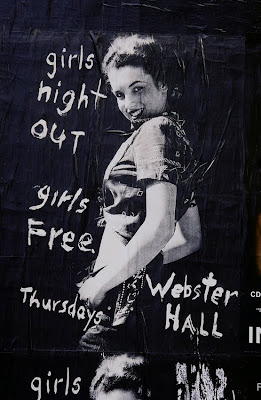
Marilyn calendar of famous Tom Kelly nude (with negligee applied). 2000Saratoga Springs, where Willie Lum’s Restaurant was located, was/is myhome town. 
NY Post, February 11, 1994. I opened to Page Six as usual and found this. 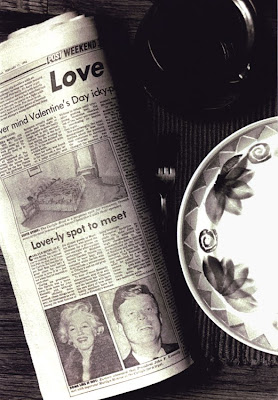
Opening the Tijuana newspaper after my husband and I had been detained there by police in 2004.
Charleston, S.C. 1997. They asked if I would photograph them. 
Barcelona, Spain, 1997. Ladies Room. 
Cardiff, Wales, 1997. There were three ways to Cardiff Castle and I was walking in the rain. I chose one street and looked up and there she was. I wasn’t even looking for Marilyn. 
London Underground, 2000. Again, stopped in my tracks, and time for only three very quick frames. 
Marilyn’s case file, annual Marilyn coverage, Brooklyn NY. August 5, 2006 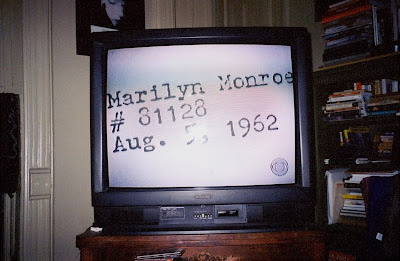
Schwabb’s Window, Memphis, 1997. Elvis shopped here. 
Rory, huge Marilyn fan, his hair salon in Quito Equador, 1997. 
Marilyn’s dresses, Christies NY 1999 auction of her former possessions. 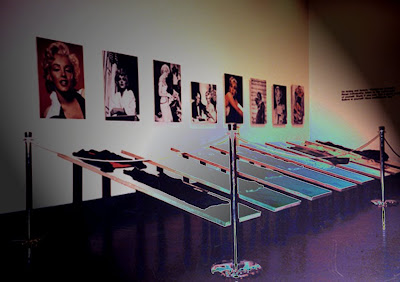
Blue Marilyn,” made from newsreel footage shot from my tv, 1992. This is the shot that started the whole project off. It was selected as the cover of an anthology of poetry, Marilyn Monroe by Lyn Lifshin. Every poem is written in Marilyn’s voice. I completed an awardwinning feature film on Lifshin in 1989, Lyn Lifshin: Not Made of Glass. Sometimes called “the female Bukowski,” Lifshin was my first in-depth look at a leading contemporary woman. Through my Combinations Press I published a companion to the film, an anthology of Lifshin’s poetry.
Peter Lawford, brother-in-law to President Kennedy, introduces Marilyn to the Madison Square Garden audience on May 19, 1962, just before she sings her tribute, “Happy Birthday Mr. President.”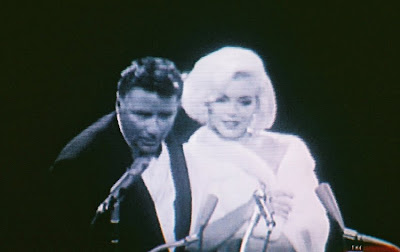
The shimmering sheath of flesh-colored gauze Marilyn wore was so tight that her assistant, Lena Pepitone, had to stitch it up the back when it came apart as she started up on stage. Christie’s auctioned it in 1999, displaying it on a constantly rotating circular platform beneath spotlights. People stood in awe. More than one said, “The dress looks like it’s breathing.” Marilyn was fond of buying the same dress in different colors. So I decided to do this Happy Birthday Mr. President” dress in different colors. Each has a different name. Less than three months after her MSG appearance, both JFK and RFK cut off relations with Marilyn, and she would be dead. Although suicide was reported, that conclusion has been widely questioned. Some have drawn similarities between her death and that of Michael Jackson. 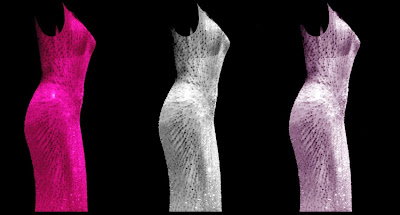
New Deal, Schwabb’s, Memphis, Tennessee, 1997. Ironic as it may seem, although Monroe has gone down in history as a sex goddess and as a symbol of sex, most of the photographs found throughout the world give as much attention to her smile and face as to her other attributes. As film scholar/historian Gene Brown has remarked, “There was only one image Garbo presented to camera. Marilyn created multitudes.” Oh, about that “sex” identity, Marilyn said, “I guess if I’m going to be a symbol of anything, I’d rather it be sex than something else.” 
Posts on Lenscratch may not be reproduced without the permission of the Lenscratch staff and the photographer.
Recommended
-
Tara Sellios: Ask Now the BeastsApril 6th, 2024
-
ALEXIS MARTINO: The Collapsing Panorama April 4th, 2024
-
Emilio Rojas: On Gloria Anzaldúa’s Borderlands: The New MestizaMarch 30th, 2024
-
Artists of Türkiye: Eren SulamaciMarch 27th, 2024
-
Love and Loss in the Cosmos: Valeria Sestua In Conversation with Vicente IsaíasMarch 19th, 2024





























































